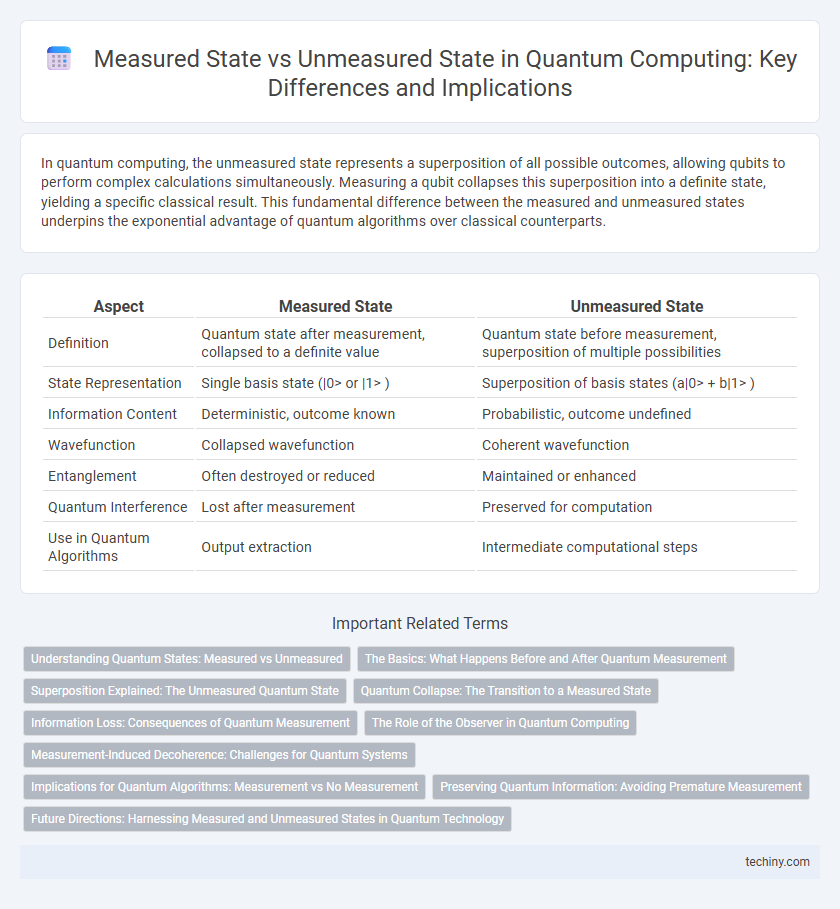In quantum computing, the unmeasured state represents a superposition of all possible outcomes, allowing qubits to perform complex calculations simultaneously. Measuring a qubit collapses this superposition into a definite state, yielding a specific classical result. This fundamental difference between the measured and unmeasured states underpins the exponential advantage of quantum algorithms over classical counterparts.
Table of Comparison
| Aspect | Measured State | Unmeasured State |
|---|---|---|
| Definition | Quantum state after measurement, collapsed to a definite value | Quantum state before measurement, superposition of multiple possibilities |
| State Representation | Single basis state (|0> or |1> ) | Superposition of basis states (a|0> + b|1> ) |
| Information Content | Deterministic, outcome known | Probabilistic, outcome undefined |
| Wavefunction | Collapsed wavefunction | Coherent wavefunction |
| Entanglement | Often destroyed or reduced | Maintained or enhanced |
| Quantum Interference | Lost after measurement | Preserved for computation |
| Use in Quantum Algorithms | Output extraction | Intermediate computational steps |
Understanding Quantum States: Measured vs Unmeasured
Quantum states exist in superposition until measured, where they collapse into a single outcome, highlighting the fundamental difference between unmeasured and measured states. Unmeasured quantum states encode probabilistic information across many potential outcomes, enabling quantum parallelism and entanglement. Measurement transforms these probabilistic wavefunctions into definite classical results, crucial for quantum algorithms and quantum information processing.
The Basics: What Happens Before and After Quantum Measurement
Quantum computing relies on qubits that exist in a superposition of multiple states before measurement, allowing parallel processing of information. When a quantum measurement occurs, the qubit's wavefunction collapses to a single eigenstate, producing a definite classical output. This transition from an unmeasured superposition to a measured eigenstate is fundamental for extracting usable results from quantum algorithms.
Superposition Explained: The Unmeasured Quantum State
The unmeasured quantum state exists in a superposition, representing all possible outcomes simultaneously through a combination of probability amplitudes. Measurement collapses this superposition into a single eigenstate, yielding a definitive classical result and eliminating other potential states. This collapse fundamentally distinguishes the unmeasured quantum system's probabilistic nature from the deterministic outcome observed post-measurement.
Quantum Collapse: The Transition to a Measured State
Quantum collapse refers to the process whereby a quantum system transitions from a superposition of multiple states to a single, definite state upon measurement. Before measurement, the quantum system exists in an unmeasured state described by a wavefunction encoding probability amplitudes for all possible outcomes. Measurement forces the wavefunction to collapse, probabilistically selecting one outcome and eliminating all others, fundamentally altering the system's state and information content.
Information Loss: Consequences of Quantum Measurement
Quantum measurement collapses a qubit's superposed state into a definitive basis state, causing irreversible information loss about the original probabilistic amplitudes. This reduction destroys the quantum coherence and entanglement vital for quantum parallelism and computational advantage. The information loss during measurement critically limits the extraction of complete quantum state information, affecting algorithm efficiency and error correction strategies.
The Role of the Observer in Quantum Computing
The role of the observer in quantum computing is pivotal, as measurement collapses a qubit's superposition into a definite state, transforming probabilistic amplitudes into classical information. Unlike unmeasured quantum states, which exist in a superposed or entangled state allowing parallel computation, the act of observation irrevocably alters the system's wavefunction. This fundamental principle dictates quantum algorithm design, emphasizing decoherence control and measurement timing to optimize computational outcomes.
Measurement-Induced Decoherence: Challenges for Quantum Systems
Measurement-induced decoherence occurs when the act of measuring a quantum system collapses its superposition state into a definite eigenstate, destroying quantum coherence essential for computation. This collapse disrupts entanglement and induces noise, posing significant challenges in maintaining qubit fidelity throughout quantum algorithms. Overcoming decoherence requires advanced error correction techniques and isolation protocols to preserve the delicate unmeasured quantum states critical for effective quantum processing.
Implications for Quantum Algorithms: Measurement vs No Measurement
Quantum algorithms exploit superposition by maintaining unmeasured states, allowing simultaneous evaluation of multiple outcomes and enhancing computational speed. Measurement collapses the quantum state, yielding definitive results but terminating quantum parallelism, which limits algorithmic depth. Balancing when to measure is crucial for optimizing performance in algorithms like Shor's and Grover's.
Preserving Quantum Information: Avoiding Premature Measurement
Quantum information remains intact in the unmeasured state due to superposition and entanglement, enabling quantum algorithms to explore multiple solutions simultaneously. Premature measurement collapses the quantum state, destroying coherence and irreversibly losing valuable computational information. Preserving quantum information by avoiding early measurement is essential for leveraging the full power of quantum computation and error correction techniques.
Future Directions: Harnessing Measured and Unmeasured States in Quantum Technology
Future directions in quantum computing emphasize leveraging both measured and unmeasured states to enhance computational power and error correction. Exploiting unmeasured superposition states facilitates quantum parallelism and coherence, while precise measurements enable readout accuracy and quantum feedback control. Integrating these approaches drives advancements in scalable quantum algorithms and robust quantum hardware architectures.
measured state vs unmeasured state Infographic

 techiny.com
techiny.com